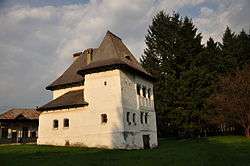Culă

Cula Greceanu from Măldărești, Vâlcea
A culă (plural: cule; from Turkish kule "tower, turret") is a semi-fortified building found in the Oltenia region of Romania with a number of examples located in the historical province of Muntenia. They were originally built as homes for the ruling Boyar class to defend against incursions by Ottoman troops during the Ottoman–Habsburg wars or against violent raids by rebels from the south of the Danube during the Stagnation of the Ottoman Empire (e.g. Osman Pazvantoğlu).
List of cule
- Cula Barbu Poenaru (1750), from Almăj, Dolj
- Cula Izvoranu, from Brabova, Dolj
- Cula Crăsnaru (1808), from Groşerea, Aninoasa, Gorj
- Cula Cornoiu from Curtişoara, Gorj
- Cula Cartianu from Cartiu, Gorj
- Cula Grecescu (1818), from Şiacu, Slivileşti, Gorj
- Cula Cuţui (1815) from Broşteni, Mehedinţi
- Cula Tudor Vladimirescu (1800) from Cerneţi, Mehedinţi
- Cula Nistor (1812), from Cerneţi, Mehedinţi
- Cula Galiţa (1790), from Câmpu Mare, Dobroteasa, Olt
- Cula Bujoreanu from Bujoreni, Vâlcea
- Cula Greceanu from Măldărești, Vâlcea (the oldest in Romania, approximately 1517)
- Cula Zătreanu from Zătreni (1754), Vâlcea
Muntenia:
- Cula Racoviţa, from Mioveni, Argeş [1]
- Cula Drugănescu from Retevoieşti, Pietroșani, Argeș , Argeş [2]
- Cula lui Costea, from Frăsinet, Teleorman
References
External links
| Wikimedia Commons has media related to Boyars. |
- http://www.kule.ro/en/ Romanian kulas
This article is issued from Wikipedia - version of the Tuesday, August 18, 2015. The text is available under the Creative Commons Attribution/Share Alike but additional terms may apply for the media files.